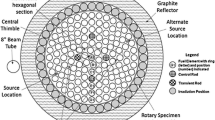Abstract
With the advent of Ge(Li) spectrometry, a high standard of purity for neutron flux monitors no longer remains an imperative “must” and becomes rather superfluous. From this standpoint, commercial grade Al was investigated for its suitability as a reactor flux monitor and was found to have a much greater practical utility than most of the monitors reported. Three Al foils and one wire were randomly selected from four different commercial sources, and analysed for their Fe, Ga, Mn and Na contents by neutron activation and high-resolution gamma-spectrometry. While Na was found to have a very heterogeneous distribution, Fe, Mn and Ga concentrations in different splits of each type of Al were consistently uniform within ±2–3%. Eight possible monitor reactions on Al, Mn, Fe and Ga have been recommended as neutron flux integrators for all the 3 components of a reactor spectrum, viz. thermal, epithermal and fast, covering a wide range of flux levels from 107 to 1014n·cm−2·sec−1. The advantages and versatility of commercial grade Al as a pile neutron dosimeter are discussed.
Similar content being viewed by others
References
Neutron Activation Technique, Chapter I—9: Neutron Detectors IAEA Bibliographic Series No. 18, Vienna 1966, p. 104.
L. M. Howe, R. E. Jervis, T. A. Eastwood, Nucl. Sci. Eng. 12, (1962) 185.
M. Fukai, Univ. of Michigan, USAEC Project No. 7, Contract No. AT(11-1) Progress reports 7 and 8, 1958 and 1959.
H. Houtermans, Private Communication, 1972.
M. S. Das, Kim Won Il and Lee Chul, Intern. J. Appl. Radiation Isotopes 20 (1969) 746.
J. R. Stehn, M. D. Goldberg, B. A. Magurno, R. Wiener-Chasman, “Neutron Cross Sections”, USAEC Report No. BNL-325, 2nd ed. 1964.
J. C. Roy, J. J. Hawton, Report No. CRC-1003 AECL-1181, 1960.
R. N. Glover, Nucl. Inst. 3 (1958) 316.
I. Heertje, A. H. W. Aten, Jr, Physica 28 (1962) 661.
F. E. Jablowski, A. F. DiMeglio, Nucl. Sci. Eng. 3 (1958) 631.
B. Fastrup, T. Olsen, Proc. Symp. Neutron Dosimetry, Vol. I, Harwell, 1962, IAEA, Vienna, 1963.
T. O. Passel, Proc. Symp. Neutron Dosimetry, Vol. I, Harwell, 1962, IAEA, Vienna, 1963.
G. Ehret, Atompraxis, 7 (1961) 393.
D. Kompe, Atompraxis, 7 (1961) 389.
W. Abson, M. Awcock, UK AERE Report No. AERE EL/M-100, 1958.
W. S. Lyon, Guide to Activation Analysis, D. van Nostrand, London, 1964.
Author information
Authors and Affiliations
Rights and permissions
About this article
Cite this article
Parekh, P.P., Heimann, M. Commercial grade aluminium: A versatile reactor flux monitor. J. Radioanal. Chem. 14, 357–365 (1973). https://doi.org/10.1007/BF02516600
Received:
Issue Date:
DOI: https://doi.org/10.1007/BF02516600




